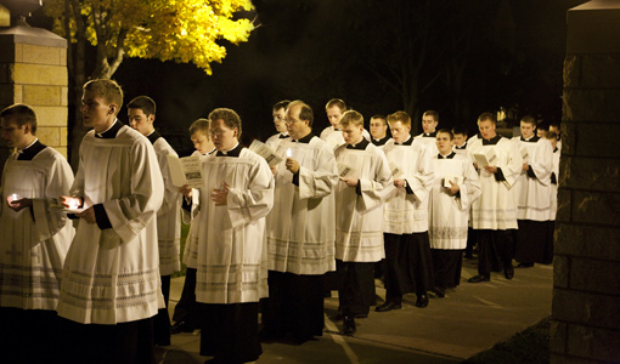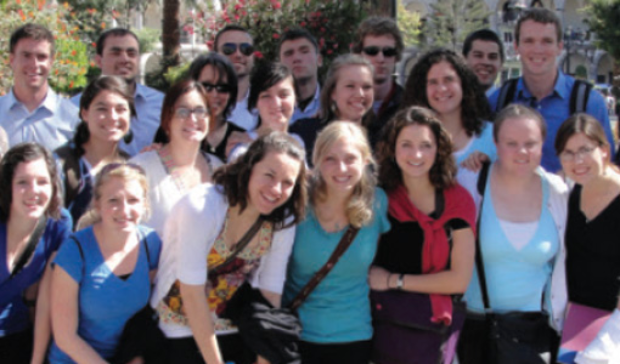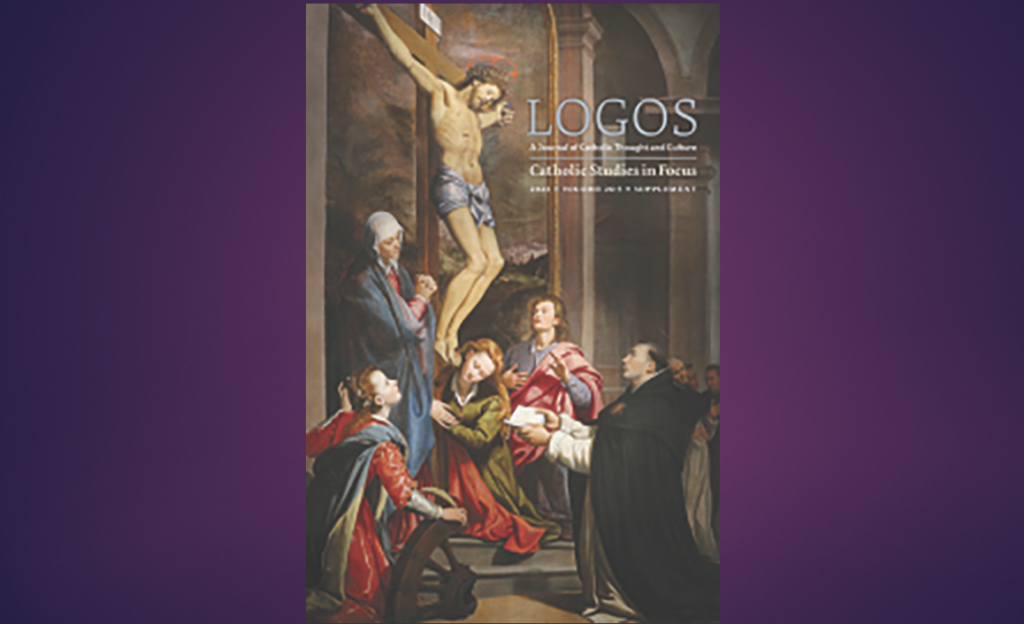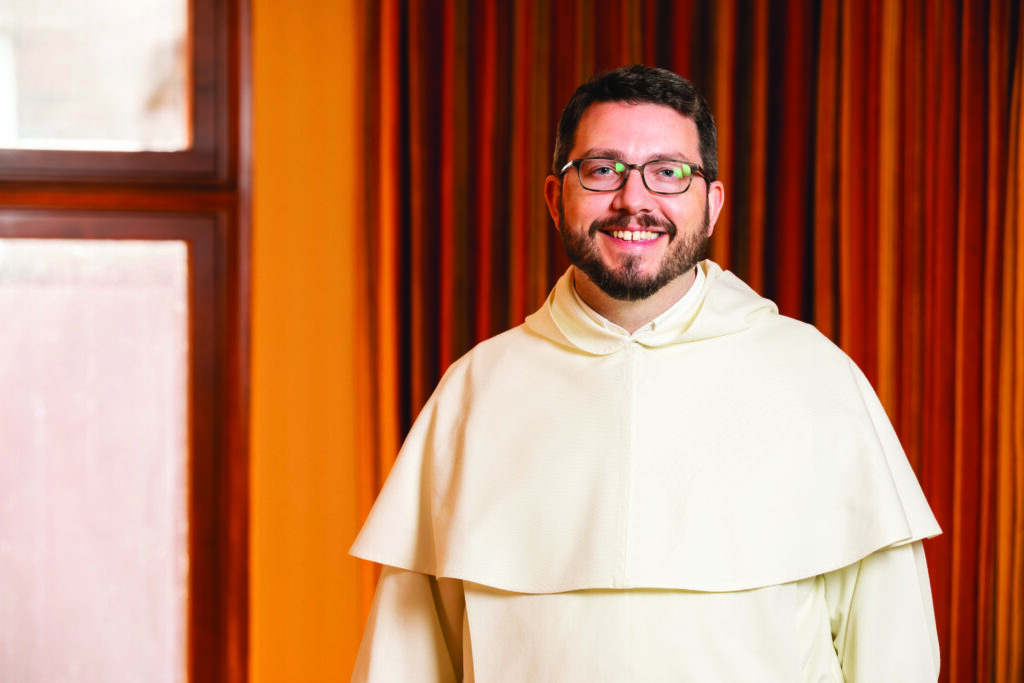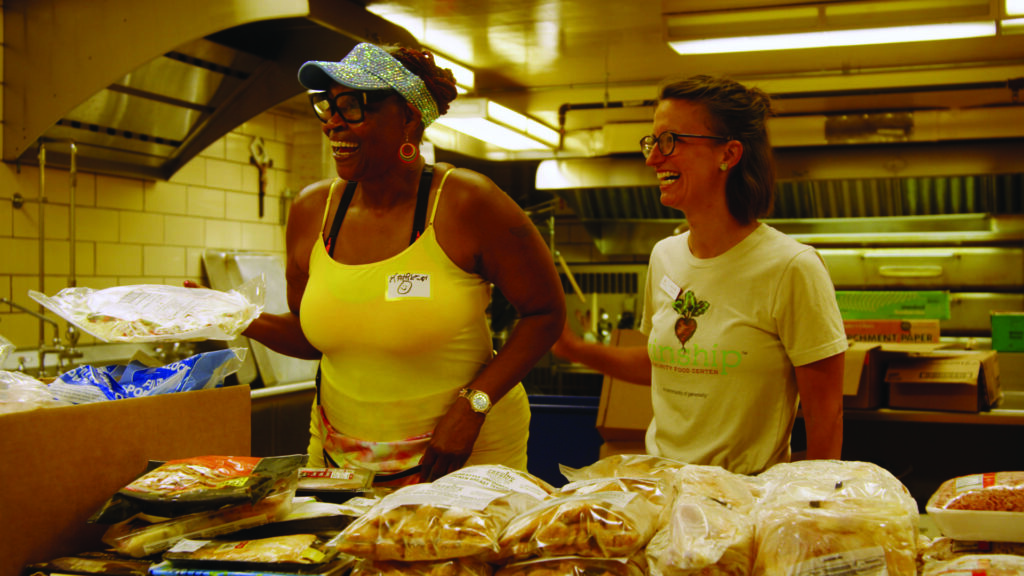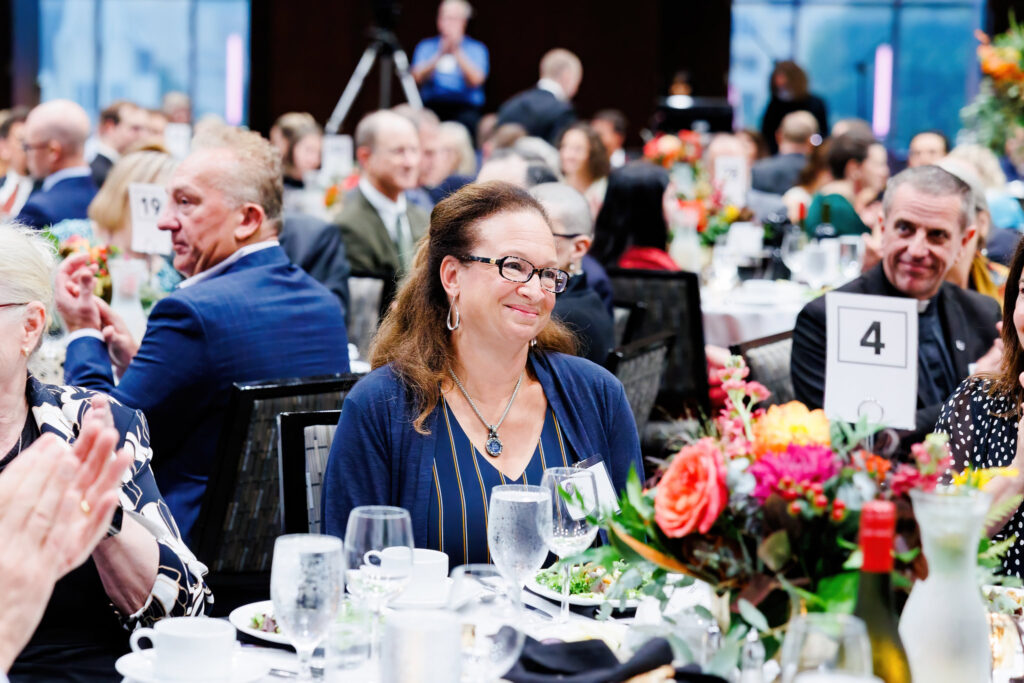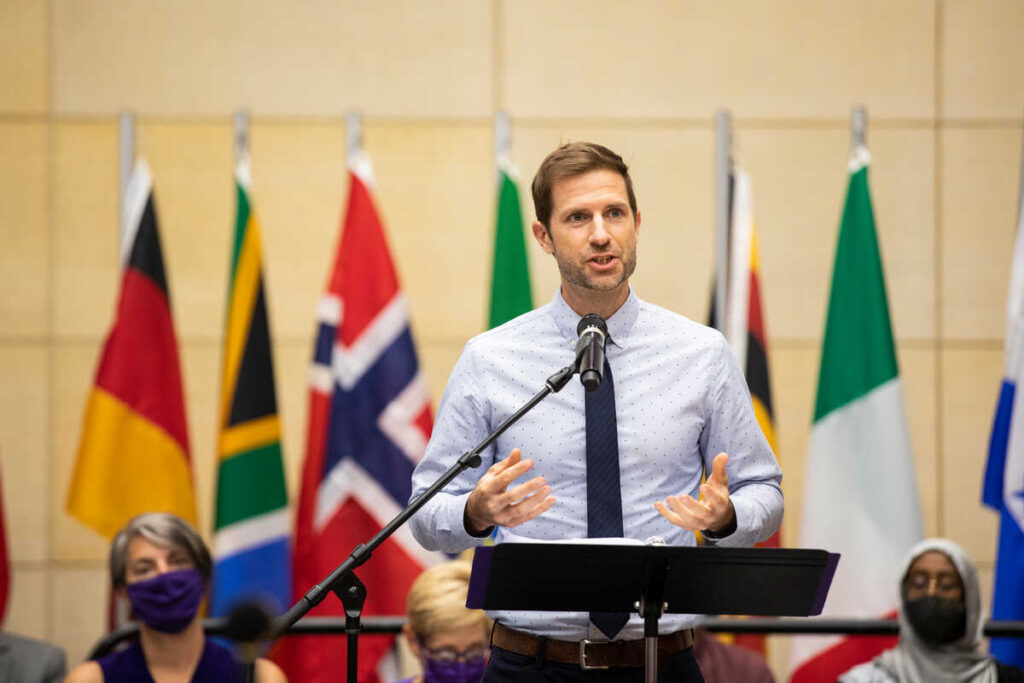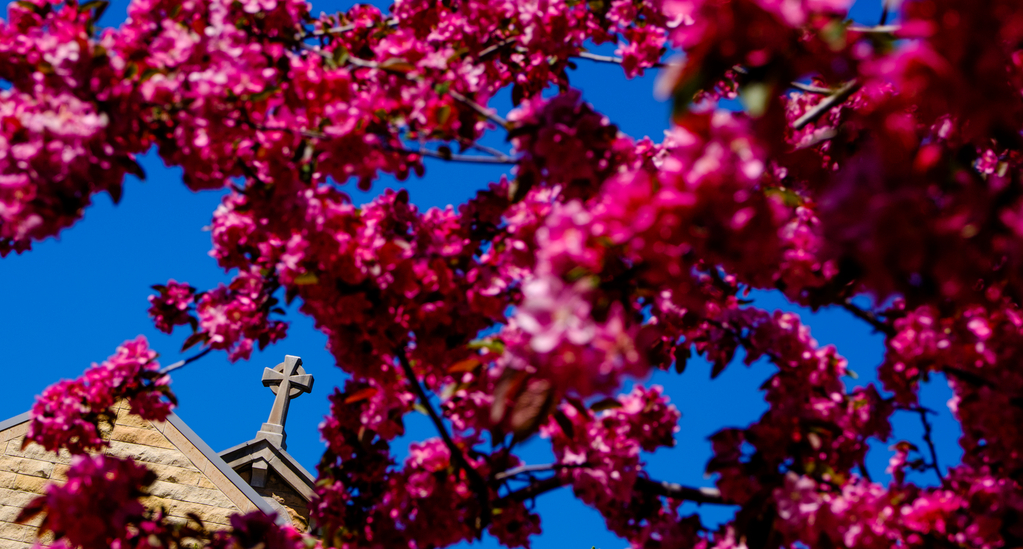The Center for Catholic Studies has a long-standing relationship with Saint John Vianney Seminary. Founded in 1968, the seminary’s mission is “to provide basic training for tomorrow’s Catholic priests.” The seminary is located on the University of St. Thomas campus, and students utilize the university’s resources. Currently 165 seminarians are enrolled at SJV.
All seminarians must major in philosophy and take two courses in Catholic Studies. Roughly 70 percent of the young men choose to go beyond these two courses and add a concentration. Why is Catholic Studies so important to these seminarians?
Catholic Studies: The symphonic witness of faith All seminarians at Saint John Vianney must take two Catholic Studies courses designed to meet their needs. Currently, Dr. John Boyle, professor of Catholic Studies and theology, and Father William Baer, rector of Saint John Vianney, teach Catholic Doctrine and Sacraments, which emphasizes parts one and two of the 1994 Catechism of the Catholic Church. Dr. Christopher Thompson, academic dean of The Saint Paul Seminary School of Divinity, and Father Baer teach Spiritual Life in the Thomistic Tradition, which covers parts three and four of the catechism.
“These classes establish a foundation from which the seminarians can explore their study,” says Thompson. “In the past, cultural cues and private Catholic education did that, but now seminarians come from a variety of backgrounds.”
Many men choose to go beyond these two required courses and choose a concentration in Catholic Studies. Father Luke Meyer ’02, chancellor for the Diocese of Fargo, pursued Catholic Studies in a desire to know more about the faith in which he was raised. Tim Lange, a senior, jokes that one of the reasons he initially chose Catholic Studies was so that he could go to Rome. “I’m very grateful I made that decision. Some of my best classes have been in Catholic Studies.”
Beyond the call of Rome, Lange also was responding to the encouragement of older seminarians. Fellow senior Dan Westermann says he decided to pursue Catholic Studies before he started his freshman year. Two recent graduates visited with young men in his area and talked about their experiences in the program, including their own semesters in Rome. “At that point, I knew. I’ve already been telling younger guys to take advantage of the opportunity. I say, ‘Even if you can’t major in Catholic Studies, just take as many courses as you can.’”
One of the primary ways Catholic Studies shapes all students, not just seminarians, is by immersing them in the Catholic intellectual tradition. Dr. Gregory Coulter, chair of the Department of Catholic Studies, notes that students have a wide intellectual engagement with theology, history, art, philosophy and literature, among other subjects. Classes cover both historic and contemporary Catholic thought. “We want students to know the mind of the Church as it is now, not just the past,” says Coulter.
Westermann appreciates the broad view of Catholic thought and culture that he has received in his classes. “You gain a fuller understanding of the Catholic Church. In my class on English Catholic writers, we pull back, and see where they fit into history as a whole.”
Lange sees Catholic Studies as a complement to his philosophy major. “You need grounding in philosophy to reason well and avoid theological errors, but Catholic Studies adds an appeal that is here and now. My classes play into each other.”
Thompson describes Catholic Studies as teaching students “to hear the symphonic witness of faith. Each one – the artist, the poet and the philosopher – is singing some kind of praise. It is reassuring to see talented, reasonable people who are giving themselves to Christianity. It is intoxicating to share in the delight of a poet and enter into his poem, to learn of an artist who embodies what you’ve been trying to say. It is frightening, because new vistas and challenges are opened up.”
These emotions that can be stirred by Catholic Studies are part of the underlying assumption behind the program, says Coulter. “Students are studying to be changed, not just out of curiosity.”
Father Steven Hoffman ’97, parochial vicar at St. John Neumann Church in Eagan, Minn., would agree. “What you are learning affects you as a person at the deepest level. It was like drinking from a fire hose at times, and I often wanted to stop the world for 24 hours to ponder and take it all in. Thankfully, the seminary provided prayer time, and so sometimes I would take what I learned in class to my times of prayer.”
Father Meyer also found a connection between prayer and his classes. “We had one hour of silent prayer in the morning. Looking back, that time provided interior peace and allowed me to receive from God through my classes a deeper understanding, knowledge and wisdom. Prayer made me more porous to receive the truth.”
Catholic Studies also encourages the seminarians and prepares them to be in but not of the world. “The world doesn’t always support what we, as Christians, are doing, so we live in tension,” says Coulter. “What Catholic Studies does is provide these seminarians with an opportunity to become integrated into the life of the university in a way that supports what they are doing.”
But while Christians live in tension with the world, they cannot turn their backs on it. “As a leader, you are more credible if you understand culture,” says Father Hoffman. “When a leader – whether a pastoral leader or a business person – seems disconnected, it gets in the way. Understanding culture as enlightened by Catholic teaching helps you see problems, become more aware of ideas working within the culture that threaten to diminish the human person. Whatever concerns human beings concerns Jesus Christ and the Church. Jesus wants to be present everywhere, even where people try to keep him out. Catholic Studies is good preparation to head out into the world.”
Christian community in Rome Each semester, between seven and 14 seminarians are among the Catholic Studies students who study at the Angelicum in Rome while living at the Bernardi campus. Their formator there is Father Joseph Carola, S.J., who is a professor of patristics at the Pontifical Gregorian University and chaplain for the Bernardi campus.
Father Carola notes that while the seminarians are in Rome, their formation is not suspended. If anything, their schedule is more intense than it is in St. Paul. Most mornings, the seminarians rise for a holy hour which begins at 5:45 a.m. They celebrate Mass daily and pray the office at other times. On Monday or Tuesday evening, depending on the semester, the seminarians participate in a weekly formation night, which begins with 6 p.m. Vespers and includes Mass at the Gregorian University, followed by pizza in the student lounge and a casual conversation reflecting on the graces and challenges of the past week. They are presented with a spiritual conference and conclude with Compline. On Wednesday evenings, all Catholic Studies students enjoy a community night, which includes confession and adoration, Vespers, Mass, discussion, dinner and Compline. Thursday is fraternity night. The seminarians split into two groups and meet without a superior in order to grow together in brotherhood. They share a meal, and then the two groups come back together for prayer. On Saturday mornings, the seminarians participate in confession and Mass. Each seminarian also has a weekly commitment to apostolic outreach, perhaps with the Missionaries of Charity at their house for homeless men or with the Little Sisters of the Lamb or the Sant Egidio community.
On top of these daily and weekly practices, the seminarians participate in a three-day silent retreat for all students at Bernardi, as well as pilgrimages to Siena and Norcia, which also includes the lay students. Finally, every two weeks each young man receives one-on-one spiritual formation from priests living at the Casa Santa Maria.
While the seminarians keep a busy schedule, their experience provides them with a great blessing. “Bernardi is an experiment in Christian community,” says Father Carola. “The students realize an unexpected joy, and Eucharist is at the very heart of it. Their communal life is centered around Wednesday nights together.” Although, he notes, it would not be good for a seminarian’s entire formation to consist of such a close community with both fellow seminarians and lay students, a semester in Rome is an exceptional moment. “All the safety nets are in place. Now they have the openness to form a community. This is the very thing a young priest has to do in a parish. Rome provides the seminarians with an initial experience in forming community with the lay faithful. They learn to recognize the gift of laity.”
This community touched Michael Garry ’09, a seminarian who is now in his first year of theological studies at the Pontifical North American College in Rome. “The community life at Bernardi was one of the greatest blessings I have received in my formation in the last four years. The Bernardi community was fundamentally a Catholic community. Within the community itself, the line that distinguished seminarian from non-seminarian, men from women, and most importantly seminarian from women, was astonishingly clear. This separation served as the foundation upon which our community was built, and, as a result, the community was tighter and more united than any other I have ever experienced. I was totally free to be a seminarian and also free to benefit from the presence of the women and lay men (which was an incredible blessing in itself). The experience of this community was for me very formative as well; because the community was centered on our Catholic faith, we were able to challenge and encourage one another openly. The nature of Bernardi helped develop in us seminarians a constant vigilance, it reminded us that as priests we will be (and are now as seminarians) necessarily public people.”
Father Carola also points out that lay students can inspire the seminarians in their faithfulness. Speaking of the lay students in Rome who are faithful to early morning holy hour, he says, “It encourages the seminarians. They have to be there. The other men and women don’t, yet they are there. The purity of their devotion is obvious. It’s a source of edification for the seminarians.”
While the seminarians may be impressed by the faithfulness of their lay brothers and sisters, their own faithfulness inspires the laity. Student Laura Kolar says, “The seminarians brought a joyful energy to Bernardi as well as a profound sense of spiritual leadership. I was struck every day by their commitment to prayer, and it was a powerful witness for me to see men actively discerning the will of God. They challenged me to be more attentive to the Holy Spirit and called on me to be a holier woman.”
“Lay men and women can have more difficulty in finding an ordered life,” says Father Carola. “The seminarians can teach them to chant the liturgy of the hours and invite them to join in nightly Rosary. They give the laity a taste of disciplined life. They wouldn’t be able to do that at Saint John Vianney.”
Student Gregory Crane agrees. “It was great having the seminarians with us in Rome. Without a doubt, the semester would not have been the same without them. At the seminary in St. Paul, the men have a regular prayer schedule of Mass, a holy hour and praying the liturgy of the hours. In Rome, that schedule continued, and the rest of us were able to reap the benefits. A lot can happen spiritually during a semester in Rome, but one must allow God to have the chance to speak.
“By the end of the semester, everyone – even those who had never touched a breviary before the semester started – knew how to pray the liturgy of the hours, knew songs and prayers of benediction, and had a new understanding of what it means to have regular prayer in one’s life.” Crane also appreciated the sense of community the seminarians brought with them to Rome. “These men come to Bernardi with an understanding of what it means to have a Catholic community, so their actions become something that the rest of us can model.”
From Catholic Studies to seminary Catholic Studies not only complements the experience of seminarians at St. John Vianney, it also prepares men who were not seminarians during their undergraduate experience for future entry into seminary. David Gockowski ’09 majored in Catholic Studies during his years as a student at St. Thomas. Gockowski had discerned a vocation to the priesthood as early as the age of 12, but, he says, “Something was holding me back.” While at St. Thomas, he lived in the Fraternity of St. Michael, a men’s house based on four pillars: prayer, study, fraternity and charity. “We were united in faith, and we became better men,” he says. It was in a course on John Henry Newman that Gockowski finally embraced his calling. “In discussing The Idea of a University, we talked about how man isn’t meant merely for contemplation but to act. Something touched my heart, and I went immediately to The Saint Paul Seminary and signed up. It opened up a new path and took away my fear. I realized that if I’m going to believe, I need to give my whole life. What you’re learning in Catholic Studies, what you’re trying to train your mind to do, can’t be separated from your heart and will.”
